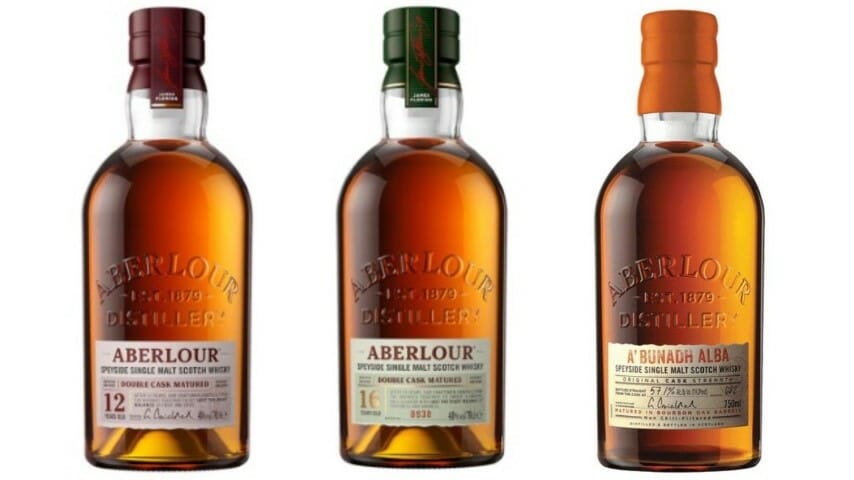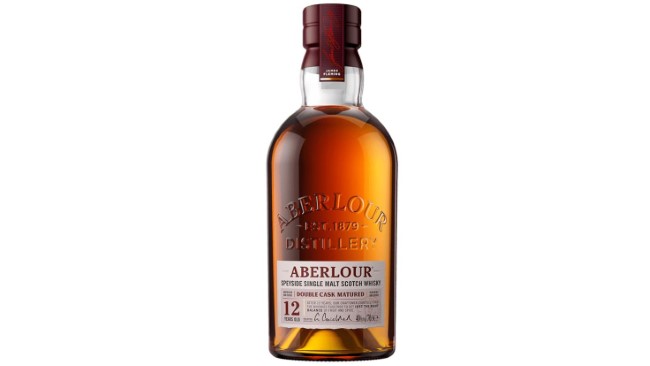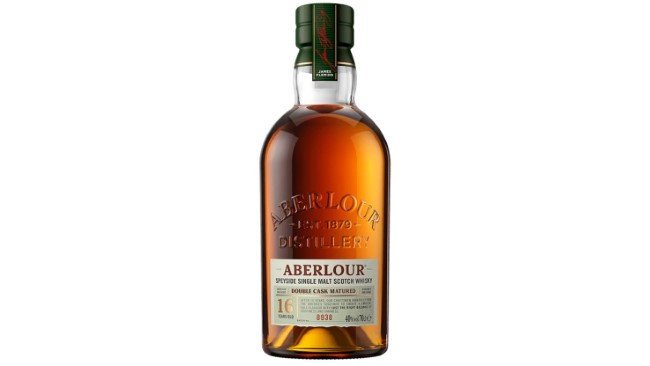Tasting: 3 Classic Sherried Single Malts from Aberlour
Photos via Aberlour, Pernod Ricard Drink Features whiskey
Single malt scotch and sherry barrels—name a more iconic duo. Like chocolate and vanilla—both flavors you’re liable to find within sherried single malt scotches, actually—some things are just natural bedfellows. And indeed, the honeyed, biscuity and orchard fruity tones of malt whisky aged within used bourbon barrels does tend to marry exceptionally well with the darker, richer fruit notes and oxidized nuttiness of sherry.
As a result, there’s no shortage of classic single malt whisky distilleries in Scotland that specialize their production in malts that are “sherried” to one degree or another, although the level of influence the sherry has on each flavor profile can vary wildly. Some distilleries go full-bore on sherry, exclusively aging their product within sherry casks or port pipes. Others primarily age in the more standard used bourbon barrels from the U.S., and then finish most of their whiskies in sherry barrels. Then there are those who use barrels that have only briefly held sherry, for marketing oomph more than anything else.
Aberlour is a classic Speyside scotch distillery, founded in 1879 by James Fleming, that falls most neatly into the double barrel aging camp. Almost all of their product lineup sees time inside sherry barrels, although the distillery doesn’t really note how much of the maturation process is inside one or the other. What Aberlour is known for is the simplicity and purity of its approach—it’s a much smaller product lineup than many modern Scottish distilleries, currently with only five or six entries in the core range. Just a few age-stated expressions, and a few NAS, cask-strength bottles. It’s neat, and elegant.
Aberlour is a well-liked distillery, not specifically known as producing “sherry bombs,” but not skimping on sherry character either. They occupy that niche for lovers of sherried single malts from Speyside, alongside contemporaries at The Glenrothes, Balvenie and Glenfarclas. Recently, I had a chance to revisit some Aberlour samples from the core range, coinciding with the annual observation of Burns Night—let’s see how the 12 year, 16 year and cask strength Aberlour A’bunadh Alba stack up against each other. I’m especially curious about the latter, as it’s a rare release from Aberlour that is not sherry barrel aged.
Aberlour 12 YearPrice: $50-60
The flagship of the Aberlour lineup is, as the age statement would obviously inform you, 12 years old. In the U.S., I believe this is the youngest age-stated Aberlour single malt available, although there are NAS cask-strength expressions. It rings in at the expected 40% ABV (80 proof) that you often expect to see in flagship expressions, or whiskies that function as gateways to curious drinkers looking to explore scotch for the first time. Like all the regular age-stated Aberlour expressions, this is aged in a combination of American white oak and sherry casks.
On the nose, Aberlour 12 is decidedly on the lighter side, with pleasant notes of red apple, florals and honey. It’s lightly viniferous, hinting at the presence of the sherry, but the wine barrel character isn’t particularly assertive. There’s also a nice spritz of something like orange essential oil.
On the palate, this has a surprisingly rich, syrupy texture for a malt whisky that weighs in at only 80 proof, something that sherry barrel aging is often able to provide. Sweet cinnamon and light red fruit are the stars of the show, along with citrus and gentle honey—although really when all is said and done, it finishes on the drier side compared to many heavily sherried malts. The sherry character here is more in the style of a supporting player, adding nuance to a malt whisky that is very easy to drink, with little ethanol presence to speak of.
All in all: An easygoing, lightly rich sipper that doesn’t go too far into desserty territory. This would surely function nicely as a basic introduction to sherried single malts, although it’s not nearly as rich or complex as some of them can ultimately be.
Aberlour 16 YearPrice: $80-90
Spending four more years in the wood, along with a subtle bump in strength to 43% ABV (86 proof) yields some much-appreciated evolution in Aberlour 16 Year. This one is noticeably darker and nuttier on the nose, with more obvious sherry character. I’m getting elements of sweet kettle corn and butterscotch, along with berry syrup and dried fruit.
On the palate, this is indeed a lovely dram, and a richer one than the 12 Year. It’s flavors have a much darker dimension, highlighting barrel char, dark chocolate and coffee, along with the “stewed prunes” and roasted nut combo of well-aged sherry. I’m getting hazelnut spread, and the twist of citrus from the 12 Year is still hanging around as well.
All in all, this one is easily the more complex of these age-stated drams, with the fittingly higher MSRP you would expect. I have noticed that Aberlour’s pricing in the U.S. from package stores can vary substantially, so be aware that this may be spotted for as little at $80, or as much as $110. Regardless, this one hits pretty close to my own personal sweet spot for sherried malt whisky flavor profiles.
Aberlour A’bunadh AlbaPrice: $80-90
This is a newer brand, and one I was curious to try for the first time. Aberlour’s core range, non-age-stated A’bunadh expression is beloved as one of the more accessible and decently priced ways to sample cask strength, sherried malt whisky, but the new A’bunadh Alba is something else entirely. It’s still a cask strength release, but it unexpectedly does away with Aberlour’s trademark sherry barrel aging to instead highlight the character of 100% first-fill bourbon barrels. This is presented unadulterated and non-chill filtered, at 57.1% ABV (114.2 proof). Clearly, this is an interesting stylistic departure. The difference is clear just from the glass—it has a significantly lighter shade, due to not having come in contact with the sherry barrels.
On the nose, my first impressions here were a little perplexing. I initially led off by noting elements of fudge and vanilla, but over time it takes a hard turn in the direction of fruitier notes—both tart green apple and more exotic tropical fruit, which is likely amplified by the ethanol, although the booze is still quite well hidden when you consider the proof. There’s a creaminess and dairy-like element to the nose as well, suggesting almost “fruit smoothie.”
On the palate, A’bunadh Alba is certainly more boisterous than either of the two age-stated expressions, with much more expressive sweetness and richness. I’m getting more of those creamy-fruity tropical notes, which are quite different from the darker and more dried fruit notes one usually associates with big sherry bombs. Interestingly, this one also turns quite spicy, with loads of sweet cinnamon, ginger and baking spices. There’s just a tease of the dark chocolate and coffee I got more strongly in the 16 year, and A’bunadh Alba closes with a faint earthiness. The ethanol, while obviously more present, is still quite gentle, and for the proof it drinks dangerously easily.
All in all, this was a fascinating departure for a distillery usually so associated with one style of doing things. I look forward to seeing what Aberlour continues to develop in the future.
Jim Vorel is a Paste staff writer and resident brown liquor geek. You can follow him on Twitter for more drink writing.


